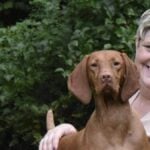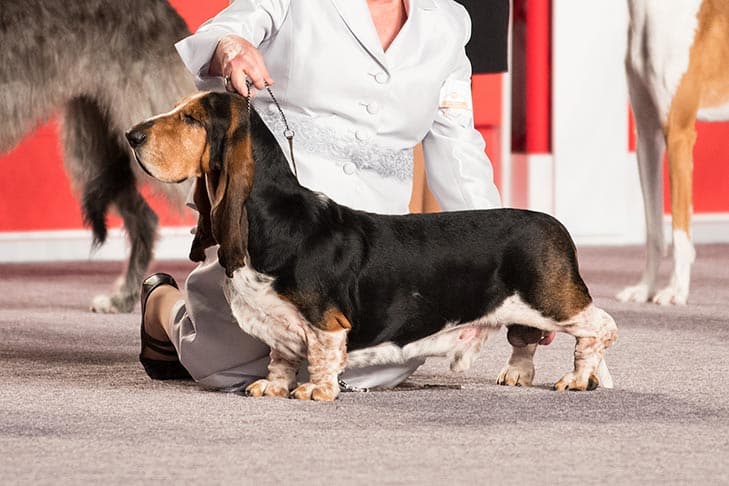
Home » Thoughts on the Basset Hound | Today and Yesterday

Thoughts on the Basset Hound by Joan Urban, Fort Merrill Bassets, passed away on August 6, 2015.
A version of this article originally appeared in the June 2015 edition of SHOWSIGHT.
I have been honored to judge the Basset Hound Club of America nationals several times, and have been made a Basset Hound Club of America life member for my work in helping to revise the Basset Hound Illustrated Standard as well as chairing the Judge’s Education Committee for a number of years,
I believe that the exhibitors of today are much better at presenting a clean, well-groomed Basset Hound than they were when I first began showing Bassets back in 1962. In any case, there is no excuse for bringing a dirty dog into the ring. Any judge will appreciate a hound with a clean coat and teeth, and properly trimmed toenails. The real hazard in judging the Basset is that they have been known to shake their head and sling their slobber. Unfortunately, once in a while it lands on an unsuspecting judge or bystander.
When assessing a Basset Hound, I like to watch each Basset as it enters the ring, and stand back and look the dog over as he or she is stacked with the other entries as well as when they are stacked individually on the ramp. Is the dog balanced front and rear? Does he possess all the characteristics consistent with “breed type” as described in the standard, “a short-legged dog, heavier in bone, size considered, than any other breed…?”
There is a great deal of wordage in the standard to describe the Basset’s beautiful, large, distinctive head. Much of the description has to do with preserving breed type. The head should be of moderate width—not narrow or broad.
The prominent occiput, the extremely long, low-set ears, and the dark, sad, slightly sunken eyes describe the breed. The third eyelid should be visible, but the eye should not have a droopy, protruding eyelid that would be nothing more than a scoop shovel for collecting debris when working in the field.
Although the Basset Hound does have loose skin over the head and body, the standard does not call for superabundant amounts of loose skin or extremely heavy bone. There should never be as much loose skin as in the Bloodhound. The description of the head is very specific and is not difficult to learn; the standard just needs to be studied. The Basset should have a scissors bite, but an even bite is acceptable.
In the last few years, a big improvement for the comfort of both exhibitor and judge has been greatly facilitated by the use of a ramp. In raising the dogs off the ground and placing them at a higher level, a judge may better see and evaluate the breed. Thankfully, I no longer see judges leaning on a Basset’s back, to assist themselves with standing up after going over the dog!
The ramp is also valuable at outdoor shows for the times when the grass covers the Basset’s feet or legs. Consider the fact that the Basset’s leg is only to be one-third their total height at the withers. Therefore, a Basset that is the proper height of fourteen inches at the withers would have front legs that would only be a little less than five inches to the deepest point of the chest. Even if a Basset were at the height limit of 15 inches at the withers, he still would have front legs that were only five inches to the deepest point of the chest. An inch or two of grass covering the feet and legs could throw off the whole balance.
In judging the Basset Hound, special attention should be paid to the forequarters, as this is where most of his weight is borne. The standard describes a hound that “…possesses in marked degree those characteristics which equip it admirably to follow a trail over and through difficult terrain.” In order to do this, he must have a good front. The correct front of a Basset is probably the most difficult to breed and also difficult for a judge to understand, if not familiar with an achondroplastic breed’s structure. The Basset shoulder blade is set-on at a 45-degree angle to the ground with 90 degrees separating the shoulder blade and upper arm. He should have a prominent sternum, with the elbows close to the side of the chest. The front legs cradle the chest and wrap around it (the “wraparound” front), but they must still leave about a “hand’s width” of space between the front legs. Both feet are “…inclined equally a trifle outward…” If the elbows are not close to the side of the chest, the Basset will be out at the elbow and/or wide in front, or both. If the shoulder is placed too far forward, the Basset will probably have no neck, and the desired sternum will be hiding behind the whole shoulder assembly. Length of neck helps him get his nose to the ground and is also a beautiful sight to see on any Basset.
Basset Hounds should be approximately twice as long as tall. I hope that the length of body is due to a nice, long, deep ribcage and not just from a long loin. The rib cage needs to be somewhat wide and deep, and oval in shape to house his heart and lungs in order that he can do the job he was bred to do. A long loin will not hold up over time. Praise God if he has a straight topline!
A Basset Hound’s rear should not be slack, but nice and round instead, and about as wide as his shoulders, with a good bend of stifle. Generally, his hind legs appear to be not as heavy in bone as the front legs, but this is mostly due to the fact that they don’t have as much loose skin as the front legs. In moving, his hind legs should have strong drive and be in perfect coordination with the front legs, and move in a straight line with the front. In spite of his short legs, he must move in a free manner with the strength and determination of an athlete. When he enters the ring, I would hope that he would exhibit this quality, and knowing that there are no rabbits in his ring at that moment, he would hold his head up proudly as he circles the ring—instead of following his natural instinct to put his nose to the floor.
His tail is set-on with a slight upward curve. I have been seeing the unfortunate reoccurrence of some sickle tails and flanged ribs lately, which I hope the breeders will be quick to remedy.
In looking back at more than a half a century of breeding and exhibiting Basset Hounds, I have had the experience of handling many of my own Fort Merrill Bassets to their championships under a variety of judges. Over a hundred Bassets carrying the Fort Merrill prefix have finished their championships. Some were campaigned under the expert hands of professional Basset Hound handlers Bryan Martin and Pat Willer. Several were ranked among the Top Hounds of the Year. CH Fort Merrill Great Gatsby (Bomber) won 78 Group placements, 24 of which were Group Firsts. Then, after winning two all-breed Bests in Show in the US, he went on to Japan to become the top-winning dog,
all-breed, in Japan in 2001. The record of CH Fort Merrill Lipz Stick (Stix) remained as the top specialty-winning bitch, from 1992 until 2014, winning three all-breed Bests in Show with 93 Group placements. These two Bassets were campaigned by Bryan Martin. CH Fort Merrill Man In Black (Manny) was shown by Pat Willer, and garnered one Best in Show with 25 Group Placements, nine of which were Group Firsts. GCH Fort Merrill Topsfield Yahoo (Yahoo) was also shown by Bryan Martin, and won two Bests in Show with 22 Group Firsts. Yahoo was co-owned by Claudia Orlandi and Kitty Stidel for his show campaign.
Currently, the top Basset Hound in my kennel is a son of Bomber by the name of GCH Fort Merrill Brunswick (Brunswick). He has been campaigned sparingly under the able hands of my friend
and kennel manager, Aaron Costilla, whom I am proud to say took Brunswick to Best of Breed at our national specialty last November.
There are two types of judges, the specialist judge and the multi-breed judge. Probably no judge can know every breed perfectly, but I would hope that all judges would be intimately familiar with the standard of the breeds they judge. They must keep up with all revised breed standards and know everything about the makeup of each breed they judge.
I know that all judges look for each dog’s best qualities first, but I have put together a quick list of Basset Hound faults and how the standard weighs them, just to help with the decision.

Featured photo by AKC.